Iranian flower valleys are in the category of plains and landscapes that may, at first glance, be compared to other places in the world except Iran. However, the reality is that these plains and Iranian flower gardens are peculiar, pristine, and extremely attractive in their way. These gardens are no different from their foreign and non-Iranian counterparts in terms of grandeur and beauty, except that they are sometimes subjected to neglect by visitors. Now, let’s take a tour of these colorful plains to have a short and enchanting journey amidst the most heavenly places in Iran.
Book Iran Air flights from London to Tehran and Tehran to London with Eligasht UK:
Iranian Flower Valleys: The Splendor of the Four Seasons of the World
Iranian flower valleys are filled with flowers that we may not even recognize. They are rainbow-like and captivating plains that require us to escape the hustle and bustle of the city and embark on a journey along the road to see them. These gardens exist in almost all cities of Iran, but some are wider and more beautiful than their counterparts. This article is similar to a scented and colorful travelogue that takes you step by step through these gardens, introducing them to you.
1. Layzangan flower plain in Fars province
First of all, we visit Fars Province and begin our fragrant journey from the Mohammadieh Flower Plain in Layzangan. It’s interesting to know that the largest Mohammadieh Flower Plain in Fars Province belongs to Darab. Most of these vast plains are cultivated with rain-fed flowers. The high production capacity of Mohammadieh flowers in this region is so significant that it can annually export a considerable portion of its production as rose essence or rosewater to the countries in the Persian Gulf region.
If you travel to this region during spring, we recommend visiting Darab and participating in the Flower and Rose Festival. Layzangan in Darab has vast and pink-colored plains that will intoxicate you with their fragrance and mesmerize you with their beauty.
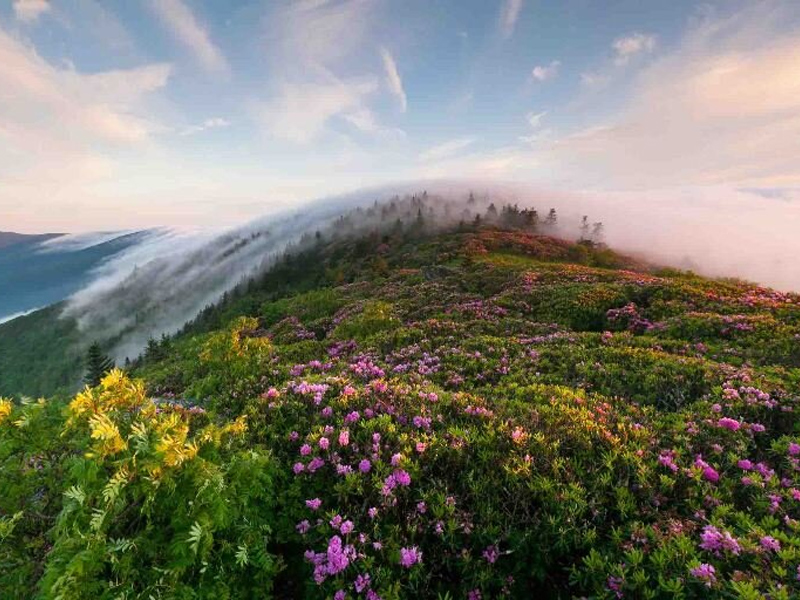
2. The sunflower field and the anemone field in Semnan’s Kalpoosh
Among Iran’s flower gardens, the wild poppy fields in Kalpoosh Semnan are in second place in terms of beauty. They attract many tourists each year, who are captivated by their charm. It’s worth mentioning that these natural beauties have led to the annual celebration of the Poppy Flowers in this region. Spring is the season of these flowers bloom, and if you choose Semnan for your Nowruz trip, you won’t regret it.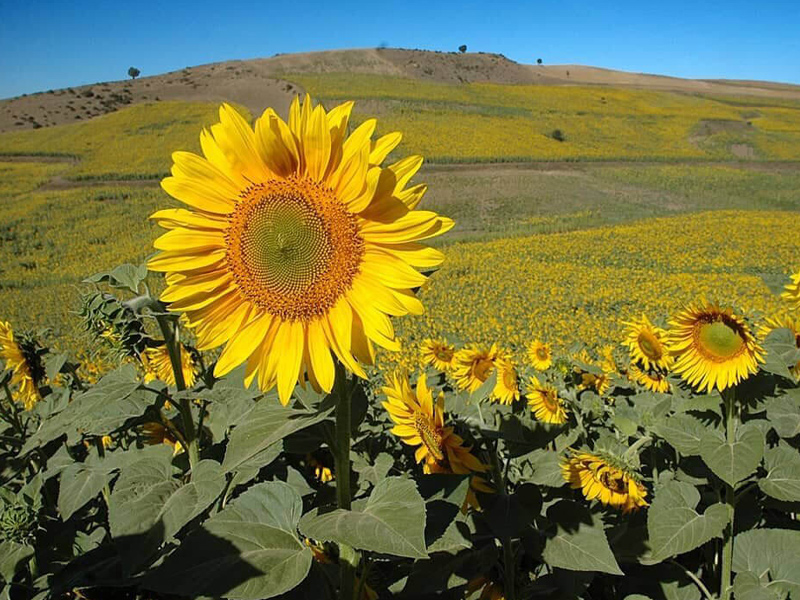
In this area, there are also sunflower plains, which are among the most beautiful sunflower gardens in Iran. It’s not to be forgotten that poppy fields and sunflower farms exist throughout different parts of Iran. However, these plains in Kalpoosh Semnan possess a unique and unparalleled beauty that is exemplary.
3. Behbahan narcissus flower plains in Khuzestan
Among Iran’s flower gardens, the Narcissus plains in Khuzestan are in the category of the most peculiar ones, and almost everyone loves these plains. It’s well-known that Khuzestan has an extremely hot climate. However, it’s necessary to remind you that due to the presence of vast plains and highly fertile soil in this region, nature showcases itself in its most beautiful form.
One of the most eye-catching and stunning natural attractions in this region is the vast Narcissus plains. As far as the eye can see, these flowers in white and yellow spread out before you and create a magnificent spectacle. These flowers usually bloom in the second half of the year and celebrate their splendor during that time.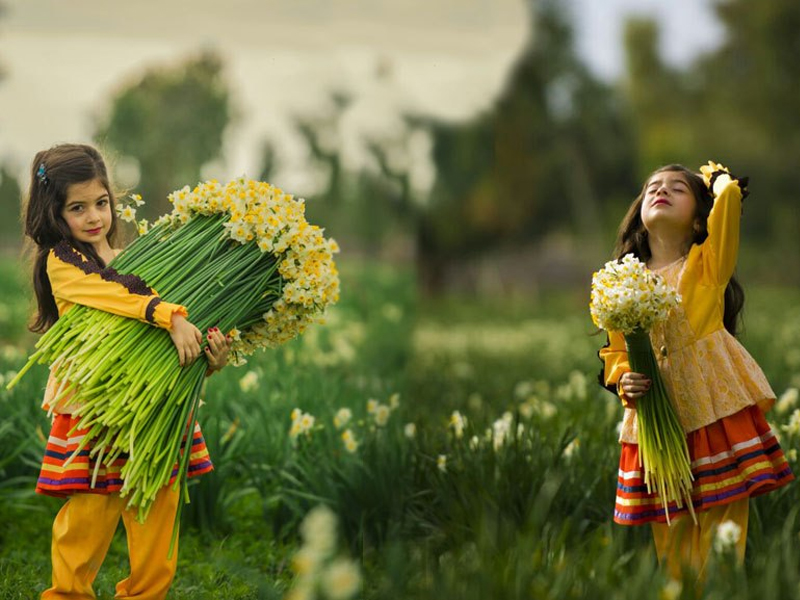
It’s interesting to know that the Narcissus fields of Behbahan have a long history and are considered the most natural and oldest Narcissus fields in southern Iran. It can even be boldly said that their story dates back to before the birth of Christ. In other words, people have been enjoying this natural beauty in this region for thousands of years. It’s worth noting that the Behbahan Narcissus fields have been registered as a national heritage and currently cultivate three different types of Narcissus. Among the three varieties, Narcissus Shahla holds the largest share.
4. Flower fields of chamomile in Fandoghloo and the city of Ardabil
It’s rare to find someone who doesn’t know that Ardabil has a cold and mountainous climate and is always covered in snow. Perhaps for this reason, the chamomile flower plain, which from a distance resembles a vast and expansive snowfield, is located in this region. At first glance, when you see this plain and the entire white flower field, you might think you are facing a chamomile field outside the country. But it is wrong; this flower plain is one of Iran’s flower fields, which, although there may be many similar ones, has a unique and amazing beauty that cannot be found anywhere else in the world. That’s why the beautiful Chamomile Flower Festival is held in Ardabil every year when the chamomile flowers bloom.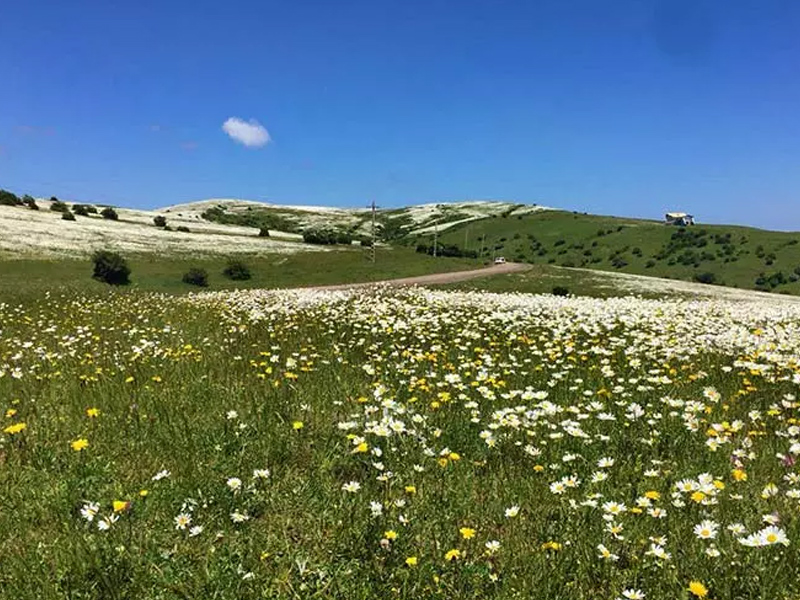
Therefore, the best time to travel to Ardabil and participate in this all-white and fragrant festival is early summer and, of course, spring. This beautiful flower plain is located in Namin County of this province and is so captivating that it will make it hard for you to blink. As you may know, chamomile is also a medicinal plant, and its extract and flowers are widely used in the cosmetics and pharmaceutical industries.
Related post
Fin Garden in Kashan: the most famous registered Iranian garden in UNESCO
Shapouri Garden: A European-Style Garden in Shiraz
5. Tulip Flower Plain in Kondor Alborz
Alborz Province and the Kondor region have a vast and colorful plain of European tulips, which is considered one of the most beautiful and unique flower fields in Iran, around Tehran. Of course, the images of this plain on social media may give you the impression that this flower field belongs to Switzerland or the Netherlands. But you are mistaken. If you decide to visit this plain, you must first go to Asara and then reach this area.
The beautiful village of Kondor is exactly located northeast of Karaj and is 22 kilometers away from it, with a distance of 7 kilometers from the Karaj-Chalus road. Access to this flower plain is very quick and easy, and if you live in Tehran, you can see this flower field in the shortest possible time.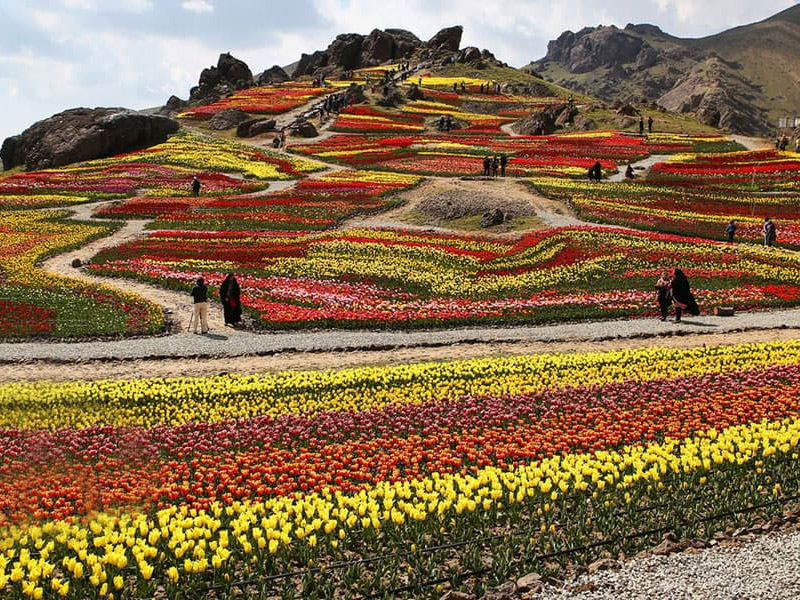
The plain of tulips in Alborz Province and the village of Kondor was opened in 2020 and was adorned with various fresh and colorful tulips thanks to the efforts of the locals, nature lovers, and enthusiasts. It is best to visit the Tulip Plain in spring. However, in this season, it attracts many lovers and enthusiasts from all over Iran.
We also recommend that if you decide to visit this flower plain, gather the necessary information about its availability beforehand and then head to this area. Sometimes, due to various reasons, this flower plain may not be accessible to tourists.
6. The Upside-Down Tulip Valley in Aligudarz, Lorestan
The Upside-Down Tulip Valley, also known as “Gol-e Ashk” in the local language, is one of the most unique flower fields in Iran, with no equivalent found anywhere else in the world. These tulips are exactly like regular tulips but with a twist. On each stem, you can see 4 to 5 tulips, turned upside down with their heads bent downward. From the center of these tulips, a white liquid similar to tears flows out, which is why they are called “Gol-e Ashk” in the local language.
In addition to Aligudarz, you can also find vast fields of Upside-Down Tulips in Fars Province and the city of Kazeroon. This type of tulip, originally from Turkistan and Afghanistan, is also present in the western Himalayas. However, it should be noted that this unique and rare flower species, mostly seen in the Zagros Mountains, is exclusively native to Iran, which has made it increasingly popular and sought after.
It’s interesting to know that this special type of Upside-Down Tulip, which is mainly found in the Zagros Mountain region, is cultivated in large areas. Therefore, the residents of the northern Zagros region enjoy watching the growth of these flowers during the spring season, while those in the southern Zagros region eagerly await the unveiling of these flowers in the summer. Furthermore, it’s worth mentioning that besides the Zagros region, you can also observe these flowers in North Khorasan and the Sabalan Mountains.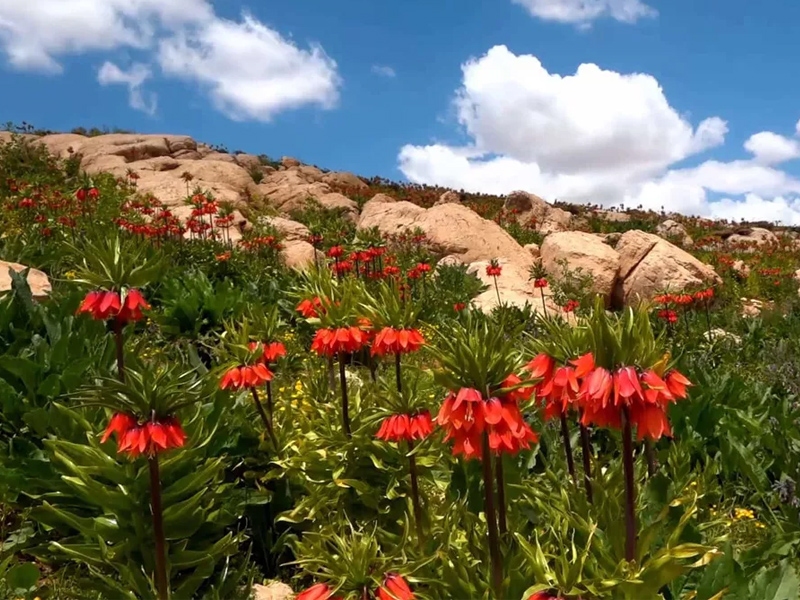
Among these regions, Aligudarz boasts one of the largest Upside-Down Tulip valleys in the world, which, alongside other vast and abundant fields of these red flowers, is considered one of the most beautiful and notable attractions in the area.
7. Chelcheragh Lily Valley in Damaash, Gilan
Finally, we come to the last flower valley in Iran, known as the Chelcheragh Lily Valley in Gilan Province, specifically in the Damaash area. You may not be aware that the Chelcheragh Lily is one of the rarest and most precious natural flowers, and due to its significant importance, it has been registered as a national heritage in Iran. These white flowers closely resemble lilies but bent over with their heads facing downward.
The locals in this area refer to these flowers as “Chelcheragh” because of their white color and their beautiful and distinctive appearance from a distance. The best time to visit the Chelcheragh Lily is in the last month of spring when the Chelcheragh Lily Festival takes place in Damaash, Gilan. During this festival, the locals celebrate the birth of these flowers with dancing and festivities, expressing their joy and happiness.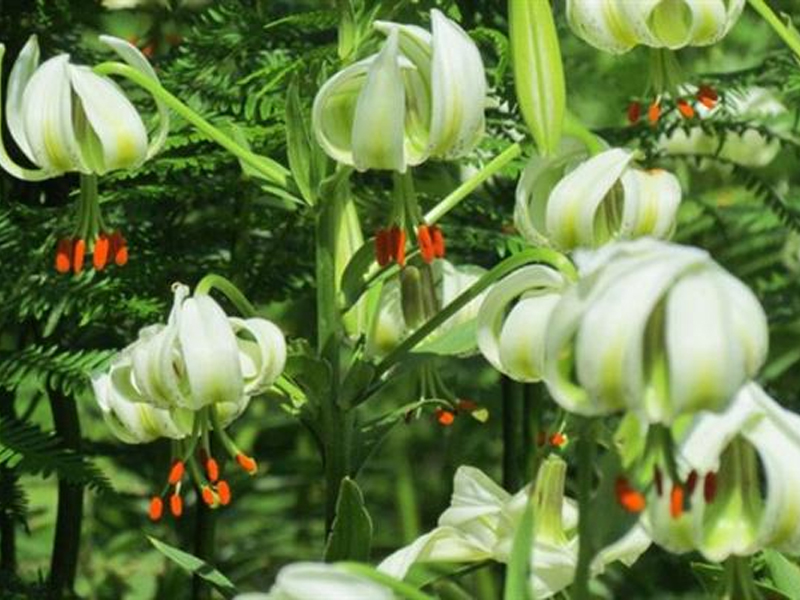
It should be noted that although these flowers have also been observed in other regions such as Dorfak, Asalem, Kajoor, Ardabil, and Kelar Dasht, their extensive spread is in Damaash. One final point to mention about these flowers is that due to their limited reproduction, their natural habitat is unfortunately endangered, putting them at risk of extinction.
Iranian Flower Valleys for a Serene Romantic Experience
This article is dedicated to the Iranian flower valleys. As mentioned earlier, while there are other wide and prominent flower valleys in other provinces, the most unique and captivating ones are the plains and flower valleys that we introduced to you in this article. Now, we recommend that when you visit these valleys, try to enjoy being in nature to the fullest and refrain from picking, damaging, or plucking these flowers. Remember that nature is an eternal heritage for us, it exists, and it will continue to exist.
FAQ
-
When is the best time to visit the flower valleys of Iran?
The best time to visit the Iranian flower valleys varies depending on the specific valley and its location. Generally, spring and early summer (April to June) are the prime seasons to witness the blooming flowers. During this time, the valleys come alive with a kaleidoscope of blossoms, including tulips, poppies, lilies, wild irises, and many more. It’s recommended to check the local blooming schedules and weather conditions for each valley before planning a visit.
-
Are there any specific flower valleys that are known for their unique species or abundance of flowers?
Yes, several flower valleys in Iran are renowned for their unique species and abundance of flowers. Some notable examples include the Rose and Rosewater Festival in Kashan and the Upside-Down Tulip Valley in Aligudarz. These valleys offer a breathtaking display of various flowers and are a treat for nature lovers.
-
Can visitors explore and hike in the Iranian flower valleys?
Yes, visitors can explore and hike in many of the flower valleys of Iran. These valleys often have designated trails or paths that allow visitors to experience the natural beauty up close. It’s important to follow any regulations or guidelines set by local authorities to preserve the delicate ecosystems. Additionally, hiring a local guide or joining organized tours can enhance the experience by providing insights into the flora, fauna, and cultural significance of the valleys.

